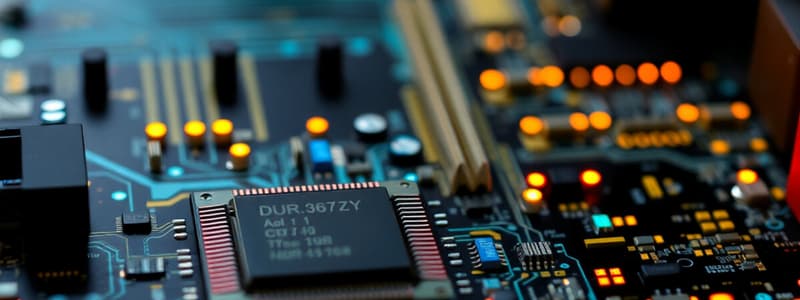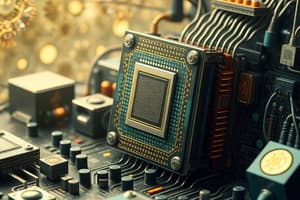Podcast
Questions and Answers
What is the function of the Control Unit (CU) in the CPU?
What is the function of the Control Unit (CU) in the CPU?
- Store data permanently
- Manage instruction execution and data flow (correct)
- Perform arithmetic operations
- Convert input data to a digital format
The Central Processing Unit (CPU) is also referred to as a microprocessor.
The Central Processing Unit (CPU) is also referred to as a microprocessor.
True (A)
Name one example of an input device.
Name one example of an input device.
Keyboard
The ________ is used to handle arithmetic and logical operations in the CPU.
The ________ is used to handle arithmetic and logical operations in the CPU.
Match the following output devices with their usage:
Match the following output devices with their usage:
Which device is NOT considered an output device?
Which device is NOT considered an output device?
Voice input devices are considered outdated technology.
Voice input devices are considered outdated technology.
What significant advancement in computer technology is represented by modern integrated circuits (ICs)?
What significant advancement in computer technology is represented by modern integrated circuits (ICs)?
Flashcards
CPU (Central Processing Unit)
CPU (Central Processing Unit)
The brain of a computer, responsible for executing instructions, performing calculations, and managing data flow.
Registers
Registers
Small, fast memory locations within the CPU used to temporarily store data and program instructions during processing.
ALU (Arithmetic Logic Unit)
ALU (Arithmetic Logic Unit)
Part of the CPU that carries out arithmetic and logical operations (like addition, subtraction, comparisons).
CU (Control Unit)
CU (Control Unit)
Signup and view all the flashcards
Input Devices
Input Devices
Signup and view all the flashcards
Output Devices
Output Devices
Signup and view all the flashcards
Evolution of Computers
Evolution of Computers
Signup and view all the flashcards
Integrated Circuits (ICs)
Integrated Circuits (ICs)
Signup and view all the flashcards
Study Notes
Computer Science - Class XI
- The CPU receives instructions and data from memory.
- It performs arithmetic and logic operations, storing results in memory.
- During processing, data and instructions are temporarily stored in CPU registers.
- Registers are limited in size and number, used for various data types.
- The CPU also has an Arithmetic Logic Unit (ALU) and Control Unit (CU).
- ALU handles arithmetic & logic operations, and the CU manages instruction execution flow.
- CU controls program execution flow and manages data flow.
Input Devices
- Input devices convert data into a digital format usable by a computer system.
- Examples include keyboards, mice, scanners, touchscreens, etc.
- Braille keyboards are designed for visually impaired users.
- Voice recognition, leveraging Google's technology, can be used to input data.
- Input data is temporarily stored in the main memory (RAM).
Output Devices
- Output devices convert digital information into a human-readable format.
- Examples include monitors, printers, 3D printers, headphones, speakers, and projectors.
- Braille displays aid in textual output interpretation for visually impaired users.
- Printers (inkjet, laser, dot matrix) produce physical output.
- 3D printers create physical replicas of digital designs.
Computer Evolution
- Computing devices evolved from simple calculators to powerful data processors.
- Early devices included the Pascaline (mechanical calculator) and tabulating machines (using punched cards).
- The ENIAC and EDVAC computers marked advancements in stored-program architecture.
- Modern computers utilize integrated circuits (ICs) for high-speed processing.
Studying That Suits You
Use AI to generate personalized quizzes and flashcards to suit your learning preferences.




